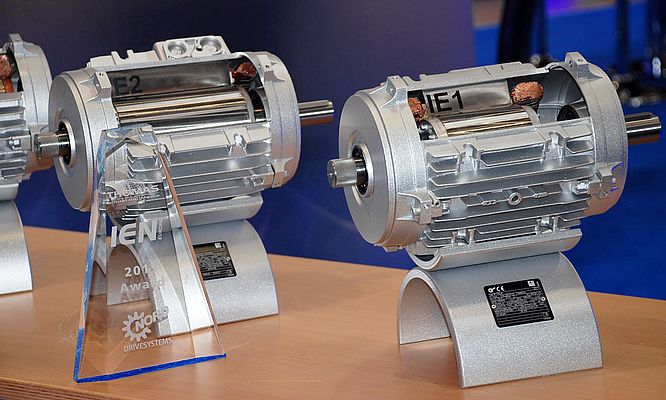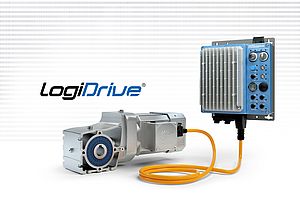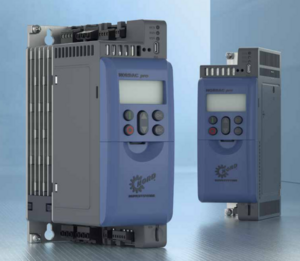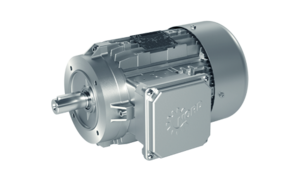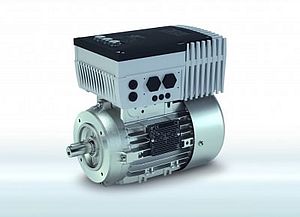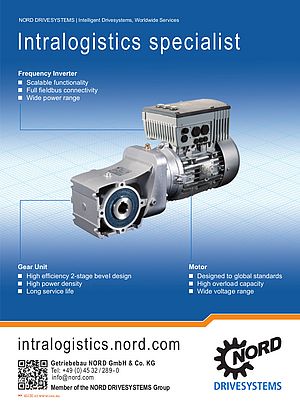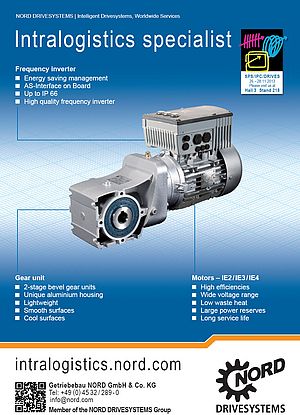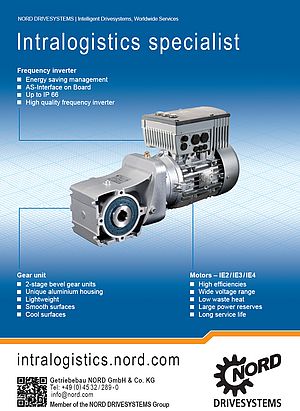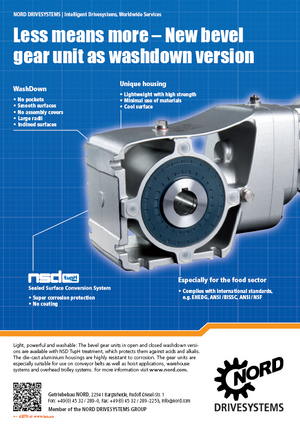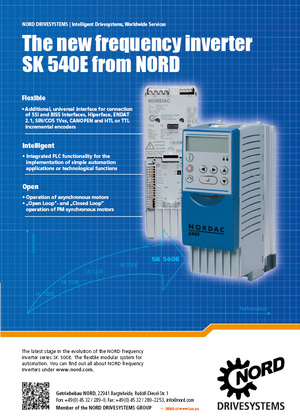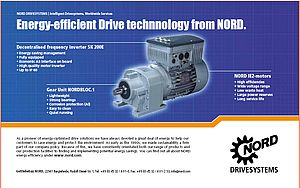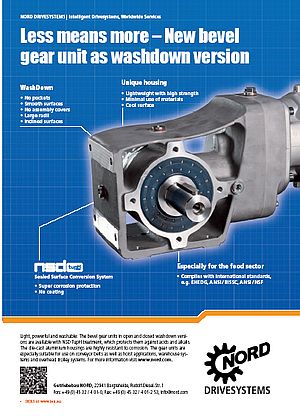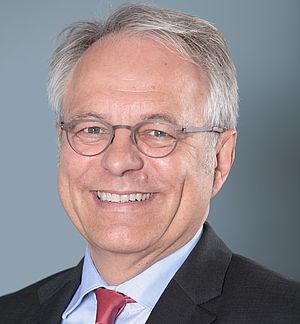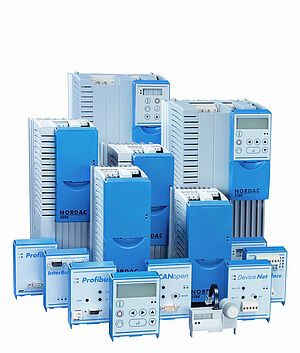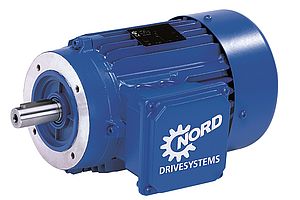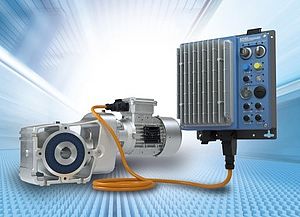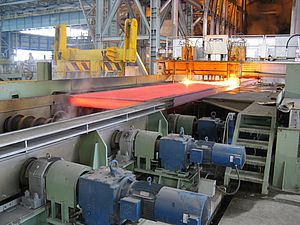Nord Drivesystems won the IEN Europe Award 2011 for its energy-efficient IE2 motors. In an exclusive interview during this year’s Hannover Messe, IEN Europe editor Jürgen Wirtz talked with Frank Wiedemann, Managing Director of Nord Electronic Drivesystems and responsible for energy-efficient motors, about the European legislation that will take effect as of June 16 this year, and the challenges it causes for manufacturers, machine builders and users.
IEN: What does the EU Directive 2005/32/EC mean for manufacturers of electrical drive technology?
Wiedemann: The Eco Design Directive 2009/125/EC, which replaces the 2005/32/EC, and its Executive Order 2009/640/EC regulates that in all countries of the European Union, all 0.75 kW to 375 kW motors have to fulfil Efficiency Class IE2 as of June 16, 2011, in case they run in continuous operation (S1). Frequency inverter applications with variable loads and driving speeds, as well as applications in hazardous areas are, to name just a few, not obliged to fulfil IE2. Furthermore, brake motors, submersible motors and motors that operate at ambient temperatures of more than +40 °C and less than -15 °C, or in altitudes above 1,000 m, are not touched by those regulations. Also, in case of intermittent and short-time duty, IE2 motors are not required. This means that we have in fact a lot of exceptions where the regular motors can still be used. For the manufacturers of electrical drive technology it means that more and more of their customers need IE2 systems, but that they still need motors that don’t fulfil the Efficiency Class IE2. So with enormous efforts in R&D and production, they had to enlarge their motor portfolio significantly to meet those demands. And in order to clarify who needs what in the future, the manufacturers had to discuss the new situation and options with their customers intensively.
IEN: Are machine engineers and users even aware of the fact that the new directive will be effective as of mid June?
Wiedemann: As I already mentioned: The intensive consulting services that manufacturers like us are providing have been and still are urgently required in most cases. Until lately, numerous machine builders have been completely unaware of their new duties. It is true that the closer we got to the deadline, the better informed our interlocutors were. But really dealing with the exceptions on a practical level was still an issue that was greatly underestimated in its complexity. For months, our project planning experts have been concentrating to define the best possible solutions for every single application, together with our customers mainly on site.
IEN: Which are the technical solutions that Nord Drivesystems has to offer in this respect?
Wiedemann: Motors with exceptional energy efficiency are in several aspects technically different from their predecessors. They contain more active material and high-quality metal sheets with less attrition, and we have improved ferrite cores within the stator slots. This makes IE2 models heavier compared to the former EFF2 models. In relatively few cases the dimensions are different as well. Machine builders and users profit from the fact that, due to those constructive modifications, we achieve better power reserves. For many applications this means that they can now do with motors of less actual power output, which can easily handle temporary peak loads. This frequently leads to a better utilisation ratio, and thus a higher efficiency of those motors during normal operation. All this shows that it is crucial to know what one can achieve with those new systems in the first place. Therefore, no manufacturer of drive technology can do without providing qualified know how. Undoubtedly, our customers aim to build the perfect solutions for their customers – but in order to achieve this goal, they must know all the options.
IEN: The fact that the launch of energy-efficient electric motors had to be enforced by legislation might lead to the assumption that manufacturers, as well as machine builders and users, didn’t quite see the need for them. How is your experience regarding that matter?
Wiedemann: Nowadays, most of those concerned know that the major part of the energy that is consumed by a machine is related to the drive technology. And one cannot say that we experience a lack of ecological consciousness. Many users, machine builders and manufacturers are parents who want to leave behind a sound and intact planet earth to their children, and they in principle endorse the measures that are taken to achieve that aim. In any case, this legislation initiated a process of reflecting on the energy efficiency of electric drive technology in general. This fact was also emphasized by the high response the issue got at this year’s Hannover Messe. Many approaches are not restricted to the motor alone, but surpass the directive by encompassing the whole system of motor, gear unit and drive electronics – within this package, the potential of saving energy are sometimes significantly higher.
IEN: To which extent are energy-efficient motors more expensive than regular ones, and when does the user reach his return on investment?
Wiedemann: Due to the higher costs in materials, energy-efficient motors are almost always more expensive than regular ones. Depending on the size, the price differences might be more or less. The additional costs for a drive system as a whole, on the other hand, are much less significant compared to the motor alone, since the gear unit and the electronics have their share as well in the total costs of the system. The return on investment very much depends on the application of the drive system. In case of a permanently operating machine, the break even point might be reached already after a few months, due to the energy costs that are saved. If a machine only operates a few hours per day, the return on investment might take longer.
IEN: In addition to the mere hardware, which information do you offer to your customers and end users on the subject of energy-efficient drive technology?
Wiedemann: As I’ve stressed several times before, the customer liaison and support is a crucial factor in that matter. Naturally, info material is important as well. For instance, our IE2 motor catalogue provides detailed information on the different energy saving requirement for various industrial branches – or if in some cases there are only recommendations and not mandatory regulations on higher efficiency classes. For example, that’s the case in South Africa. Apart from our individual customer support, we provide an online information platform under www.nord.com/IE2. Among other things, you can find a decision-making aid, as well as our efficiency calculator on this website. In case you would like to know the return on investment of a specific drive solution for a specific application, you can calculate this online.
IEN: The EU Directive mentioned before is one thing. But up to now there have been different international efficiency standards for electric motors. Are there initiatives to harmonize those standards?
Wiedemann: Of course, every once in a while we see efforts for a better harmonization. Basically, the purpose of the different IE degrees was to establish a worldwide standard. And a common nomenclature according to this system is already a success in and of itself. However, in the foreseeable future we will probably have to deal with the different regulations in different geographical regions. Despite the fact that everybody is striving to save energy, we have different situations around the globe. In North America, for example, the efficiency class “Premium Efficiency” – which means IE3 – is required. This has been effective as of December 2010 in the US and January 2011 in Canada for motors from 1 up to 200 HP – Americans don’t think in terms of kW. In Europe, on the other hand, efficiency class IE3 will only be mandatory as of 2015, and this only for motors from 7.5 kW on. China, to take a look at the Asian market, calls the IE2 classification “Grade 2”, which is mandatory as of July 2011. In contrast to Europe this not only concerns the motors as of 0.75 kW, but already those as of 0.55 kW. In India, to take another example, IE2 classification will probably only take effect as of 2013 – but presumably already for motors as of 0.37 kW.
IEN: In the future, will there be more restrictive energy efficiency classes, maybe also for other engine-power classes?
Wiedemann: It is already a fact that we will have more strict demands on motors. The exact design and details partly still have to be determined, but decisions have been taken that, by and by, motors of energy class IE3 will be mandatory – and already is in some parts of the world, as mentioned before. Deadlines, areas of application and many details and exceptions distinctly vary from region to region. IE3 motors have to be at least ten percent more efficient than IE2 motors. To achieve this, different materials will at least be partly necessary. In any case it is necessary to reduce the rotor losses decisively. The next step, efficiency class IE4, is already being prepared. The further development of the systems is also a sure thing. For the time being, most of the OEMs and users in Europe have enough to do with establishing IE2.
IEN: Mr Wiedemann, thank you very much for the interview.


